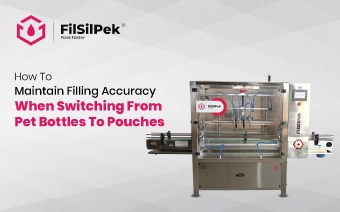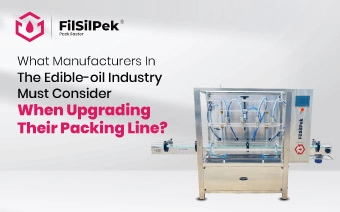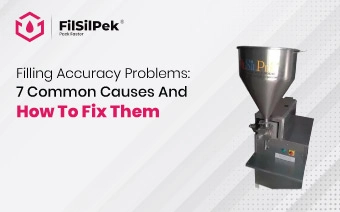What Makes Filsilpek’s Viscous Filling Line a Trusted Choice for Food Manufacturers?
In the food manufacturing industry, handling thick or semi-solid products presents unique challenges. Unlike water-thin liquids, viscous materials such as sauces, pastes, honey, jams, and dairy spreads resist easy flow and require specialized equipment to fill accurately and efficiently. Standard liquid fillers often struggle with these products, leading to inconsistent fills, product waste, or frequent downtime.
To meet these demands, food producers need filling systems that combine precision, durability, and adaptability. A reliable viscous filling line must not only manage the physical properties of thick products but also comply with food safety standards, support high-speed production, and integrate smoothly into existing packaging workflows. This balance of performance and practicality is essential for maintaining quality, reducing costs, and meeting consumer expectations.
Filsilpek’s viscous filling solutions are engineered specifically for these needs. In this article, we’ll explore the technical strengths, operational benefits, and industry-focused design elements that make their filling lines a trusted choice among food manufacturers.
Why Viscous Products Need Specialized Filling Technology
Viscous and semi-solid products such as curry paste, honey, hot balm, or melted wax do not flow freely like water or thin liquids. Their high internal resistance means they require positive displacement methods to move and dose accurately. Standard filling systems that rely on gravity, suction, or centrifugal force often fail to deliver consistent volumes, leading to underfills, product waste, or air entrapment.
These materials can also be temperature-sensitive, changing viscosity as they cool or heat. A filling system must handle this variability without clogging, dripping, or losing accuracy. Additionally, many viscous food and cosmetic products are sticky or dense, which increases wear on pumps and valves. Specialized filling technology addresses these challenges with robust mechanics, precise control, and hygienic design.
- Thick products resist flow and cannot be filled accurately with gravity-based systems.
- Positive displacement (e.g., piston) is required to ensure consistent volume delivery.
- Temperature changes can alter viscosity during filling, affecting accuracy and flow.
- Sticky or fibrous materials may clog narrow nozzles or standard pump mechanisms.
- Air entrapment in viscous fluids can cause foaming, weight variation, or visual defects.
- Standard liquid fillers often drip or leave residue with thick products, creating mess and waste.
- Hygienic design is critical since viscous residues can harbor bacteria if not cleaned properly.
- High-viscosity filling demands more mechanical force, requiring durable components and stable drives.
Key Strengths of Filsilpek’s Viscous Filling Line
Filsilpek’s viscous filling line is built for dependable, high-performance operation when handling thick or semi-solid products across food, cosmetics, pharmaceuticals, and other industries. The machine uses a mechanical piston system that ensures consistent fill volumes regardless of product texture or temperature. Designed with practicality in mind, it supports fast production, easy cleaning, and smooth integration into existing packaging lines all while meeting hygiene and efficiency standards expected in modern manufacturing.
- Mechanical Piston Filling System
The machine uses a positive displacement piston mechanism that draws and dispenses a fixed volume of product with every cycle. This method is especially effective for viscous or semi-solid materials like curry paste, honey, or melted wax, which do not flow easily through pump- or gravity-based systems. Because the piston physically pushes the product out, there is minimal variation between fills, even over long production runs. This design also reduces the risk of air entrapment or foaming, which can affect product quality and appearance. - Filling Range: 50 gm to 1,000 gm
The system can be adjusted to handle fill volumes from as little as 50 grams ideal for sample sizes or travel packs up to 1,000 grams for standard retail containers. This wide range allows manufacturers to use the same machine for multiple SKUs without major reconfiguration. Volume adjustments are made mechanically through the piston stroke length, which is simple to calibrate and does not require software or electronic recalibration. This flexibility supports businesses that produce varied product lines or seasonal packaging formats. - 4 Filling Heads (Syringes)
Equipped with four independent syringes and pistons, the machine fills four containers simultaneously during each cycle. This parallel operation significantly increases throughput while maintaining individual control over each fill station. The heads are spaced to accommodate standard jar and bottle footprints, and each syringe can be serviced or replaced without affecting the others. This modular setup improves uptime and makes maintenance more manageable during routine checks or cleaning. - Output of 1,500 to 2,100 Containers per Hour
Depending on product viscosity, container size, and operator settings, the machine delivers between 1,500 and 2,100 filled units per hour. This output level suits small to medium-scale production environments where balancing speed and accuracy is essential. The rate is consistent across different product types because the piston system is not affected by changes in flow resistance. This reliability helps manufacturers meet daily targets without overburdening the line or compromising fill quality. - “No Bottle, No Fill” Function
The machine includes a sensor-based interlock that prevents dispensing unless a container is correctly positioned under a filling head. This feature eliminates product waste from accidental discharges and keeps the conveyor and surrounding area clean. It also reduces the risk of cross-contamination and minimizes cleanup time between batches. For facilities running lean operations, this function supports both cost control and hygiene compliance. - Variable AC Frequency Drive for Speed Adjustment
Operators can fine-tune the machine’s cycle speed using an AC frequency drive, allowing adaptation to different product behaviors. Thicker products like hot balm or wax may require slower cycles to ensure complete piston discharge, while lighter creams can run faster. The drive provides smooth acceleration and deceleration, reducing mechanical stress on components. This adjustability makes the machine versatile across product categories without sacrificing performance. - Minimal Changeover Time
Switching between container types or fill volumes requires only basic mechanical adjustments no custom tooling or lengthy recalibration. Height, width, and volume settings can be modified by line staff using hand tools or simple dials. This design supports frequent product rotations, which is common in co-packers or brands with diverse portfolios. Reduced changeover time translates directly into higher machine utilization and lower labor costs. - Compact and Space-Efficient Design
The machine has a small footprint, making it suitable for production floors with limited space. Despite its compact size, it maintains full functionality and structural rigidity for continuous operation. All controls and access points are positioned for ease of use, and the layout allows for straightforward integration with conveyors, cappers, or labeling systems. This efficient use of space helps manufacturers expand capacity without facility modifications. - Total GMP-Compliant Construction
Built to meet Good Manufacturing Practice (GMP) standards, the machine uses food-grade stainless steel for all product-contact surfaces. The design avoids crevices or hard-to-clean areas, supporting thorough sanitation between batches. Smooth surfaces and open access panels make visual inspection and cleaning faster and more effective. Compliance with GMP is essential for food, cosmetic, and pharmaceutical producers subject to regulatory audits. - Minimum Maintenance Requirements
The mechanical design relies on proven components with long service life, such as industrial-grade seals, linear guides, and robust drive systems. Routine maintenance involves basic lubrication and periodic seal checks tasks that can be performed during scheduled breaks. Fewer electronic dependencies mean fewer points of failure, contributing to stable, uninterrupted operation over time. This reliability reduces both downtime and the total cost of ownership. - Versatile Across Multiple Industries
While commonly used for sauces and curry pastes, the machine is equally effective for honey, shampoo, cosmetics, lip balm, hot wax, and even paint. Its ability to handle products in melted or semi-solid states makes it valuable for businesses working with temperature-sensitive formulations. This cross-industry adaptability demonstrates the system’s robust engineering and broad functional scope. Manufacturers can invest in one platform for diverse applications, simplifying their equipment strategy.
Tips for Maximizing Efficiency with a Viscous Filler
To get the most out of a viscous filling line, food manufacturers should consider a few practical steps:
- Maintain consistent product temperature: Many viscous foods flow more predictably when kept at a stable, optimal temperature.
- Use compatible container designs: Wide-mouth jars or bottles with smooth interiors help prevent product hang-up and ensure complete filling.
- Schedule routine maintenance: Even low-maintenance systems benefit from regular checks of seals, pistons, and sensors to sustain long-term accuracy.
- Train operators on speed adjustments: Understanding how viscosity affects fill rate helps teams optimize the AC drive settings for each product.
These small but impactful practices can extend machine life, improve fill consistency, and reduce operational hiccups.
Summing it up
When it comes to filling thick food products, cutting corners on equipment can lead to bigger costs down the line through waste, rework, or compliance issues. Filsilpek’s viscous filling line offers a smart balance of engineering precision, food-grade safety, and real-world reliability that food producers can depend on.
If you’re evaluating filling solutions for your food production line, it’s worth seeing how Filsilpek’s technology can fit your needs. Reach out to their team at [email protected] they’re ready to help you fill smarter, not harder
How to Maintain Filling Accuracy When Switching from PET Bottles to Pouches
Moving from PET bottles to flexible pouches changes more than your packaging design It changes….
What Manufacturers in the Edible-Oil Industry Must Consider When Upgrading Their Packing Line?
Upgrading the packing line doesn’t mean getting newer machine…
Filling accuracy problems: 7 common causes and how to fix them
In every production unit where filling is at the heart of operations…



